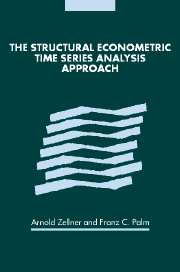Book contents
- Frontmatter
- Contents
- List of contributors
- Acknowledgments
- Introduction
- Part I The SEMTSA approach
- Part II Selected applications
- 6 Time series and structural analysis of monetary models of the US economy (1975)
- 7 Time series versus structural models: a case study of Canadian manufacturing inventory behavior (1975)
- 8 Time series analysis of the German hyperinflation (1978)
- 9 A time series analysis of seasonality in econometric models (1978)
- 10 The behavior of speculative prices and the consistency of economic models (1985)
- 11 A comparison of the stochastic processes of structural and time series exchange rate models (1987)
- 12 Encompassing univariate models in multivariate time series: a case study (1994)
- Part III Macroeconomic forecasting and modeling
- Part IV Disaggregation, forecasting, and modeling
- Subject index
- Author index
- References
9 - A time series analysis of seasonality in econometric models (1978)
Published online by Cambridge University Press: 24 October 2009
- Frontmatter
- Contents
- List of contributors
- Acknowledgments
- Introduction
- Part I The SEMTSA approach
- Part II Selected applications
- 6 Time series and structural analysis of monetary models of the US economy (1975)
- 7 Time series versus structural models: a case study of Canadian manufacturing inventory behavior (1975)
- 8 Time series analysis of the German hyperinflation (1978)
- 9 A time series analysis of seasonality in econometric models (1978)
- 10 The behavior of speculative prices and the consistency of economic models (1985)
- 11 A comparison of the stochastic processes of structural and time series exchange rate models (1987)
- 12 Encompassing univariate models in multivariate time series: a case study (1994)
- Part III Macroeconomic forecasting and modeling
- Part IV Disaggregation, forecasting, and modeling
- Subject index
- Author index
- References
Summary
Introduction
The traditional literature on seasonality has mainly focused attention on various statistical procedures for obtaining a seasonally adjusted time series from an observed time series that exhibits seasonal variation. Many of these procedures rely on the notion that an observed time series can be meaningfully divided into several unobserved components. Usually, these components are taken to be a trend or cyclical component, a seasonal component, and an irregular or random component. Unfortunately, this simple specification, in itself, is not sufficient to identify a unique seasonal component, given an observed series. Consequently, there are difficult problems facing those wishing to obtain a seasonally adjusted series. For example, the econometrician or statistician involved in this adjusting process is immediately confronted with several issues. Are the components additive or multiplicative? Are they deterministic or stochastic? Are they independent or are there interaction effects? Are they stable through time or do they vary through time? Either explicitly or implicitly, these types of questions must be dealt with before one can obtain a seasonally adjusted series.
One approach to answering some of these questions would be to incorporate subject-matter considerations into the decision process. In particular, economic concepts may be useful in arriving at a better understanding of seasonality. Within the context of an economic structure (e.g. a simple supply and demand model), the seasonal variation in one set of variables, or in one market, should have implications for the seasonal variation in closely related variables and markets.
- Type
- Chapter
- Information
- The Structural Econometric Time Series Analysis Approach , pp. 332 - 396Publisher: Cambridge University PressPrint publication year: 2004
References
- 2
- Cited by



